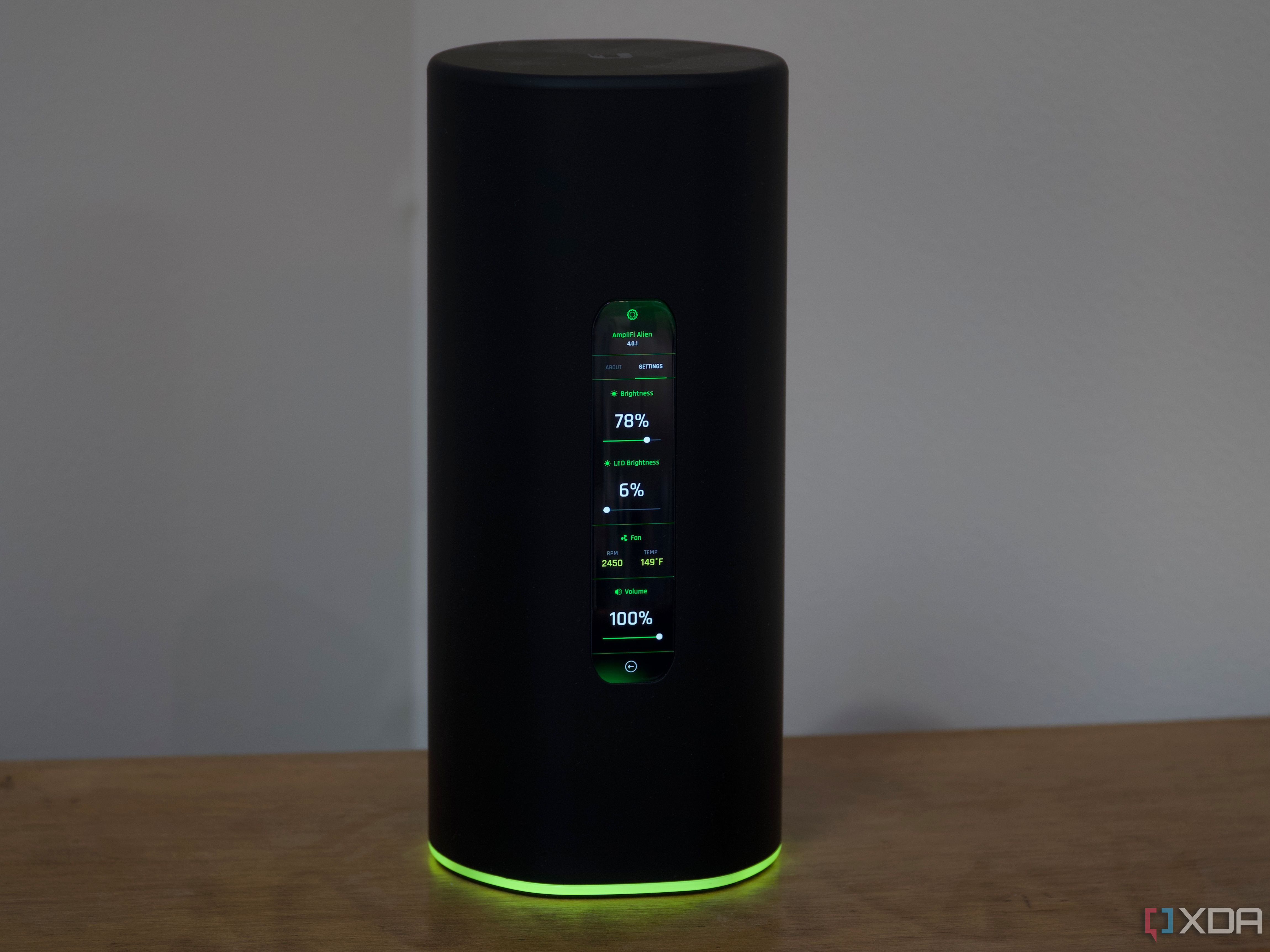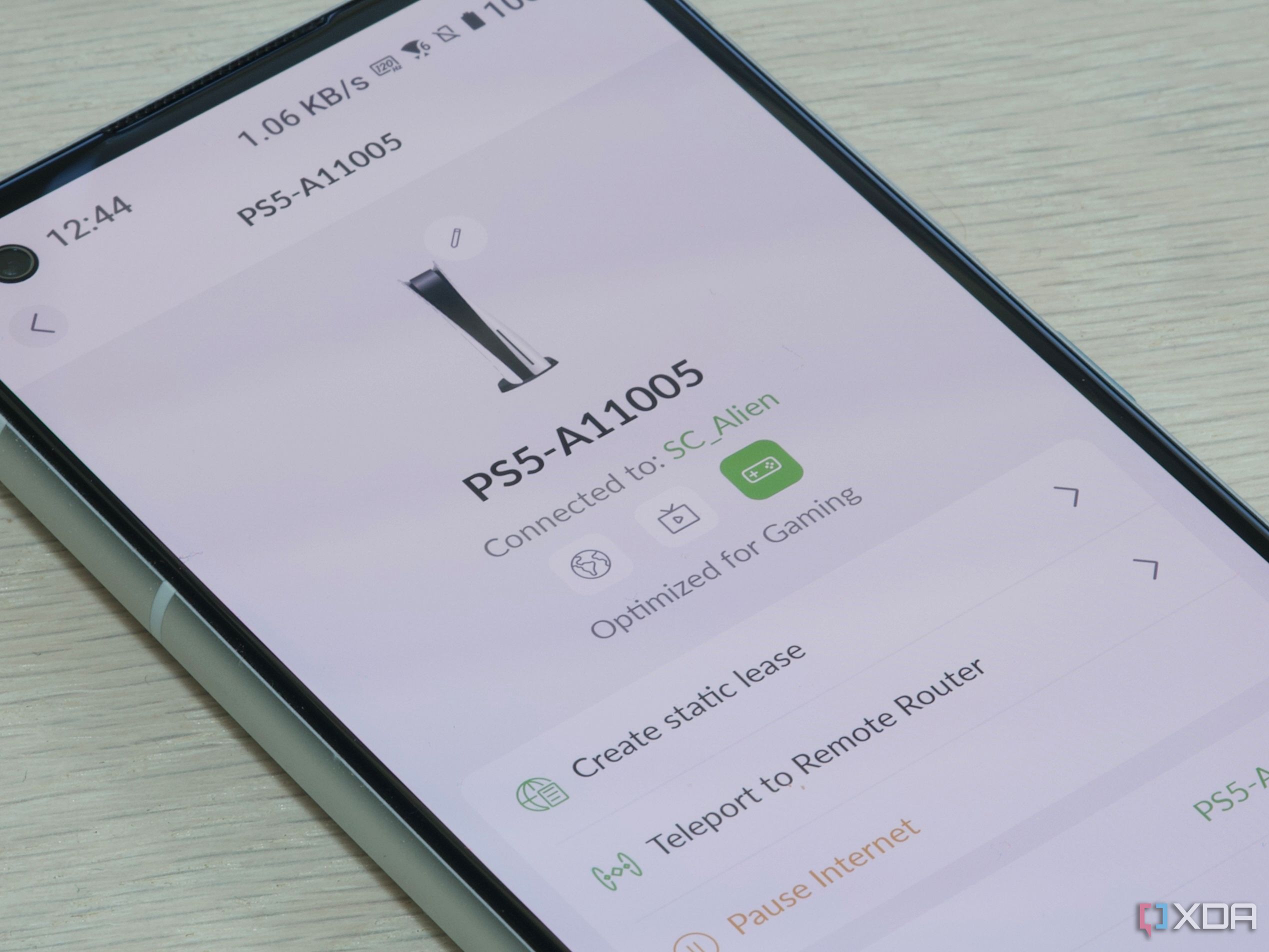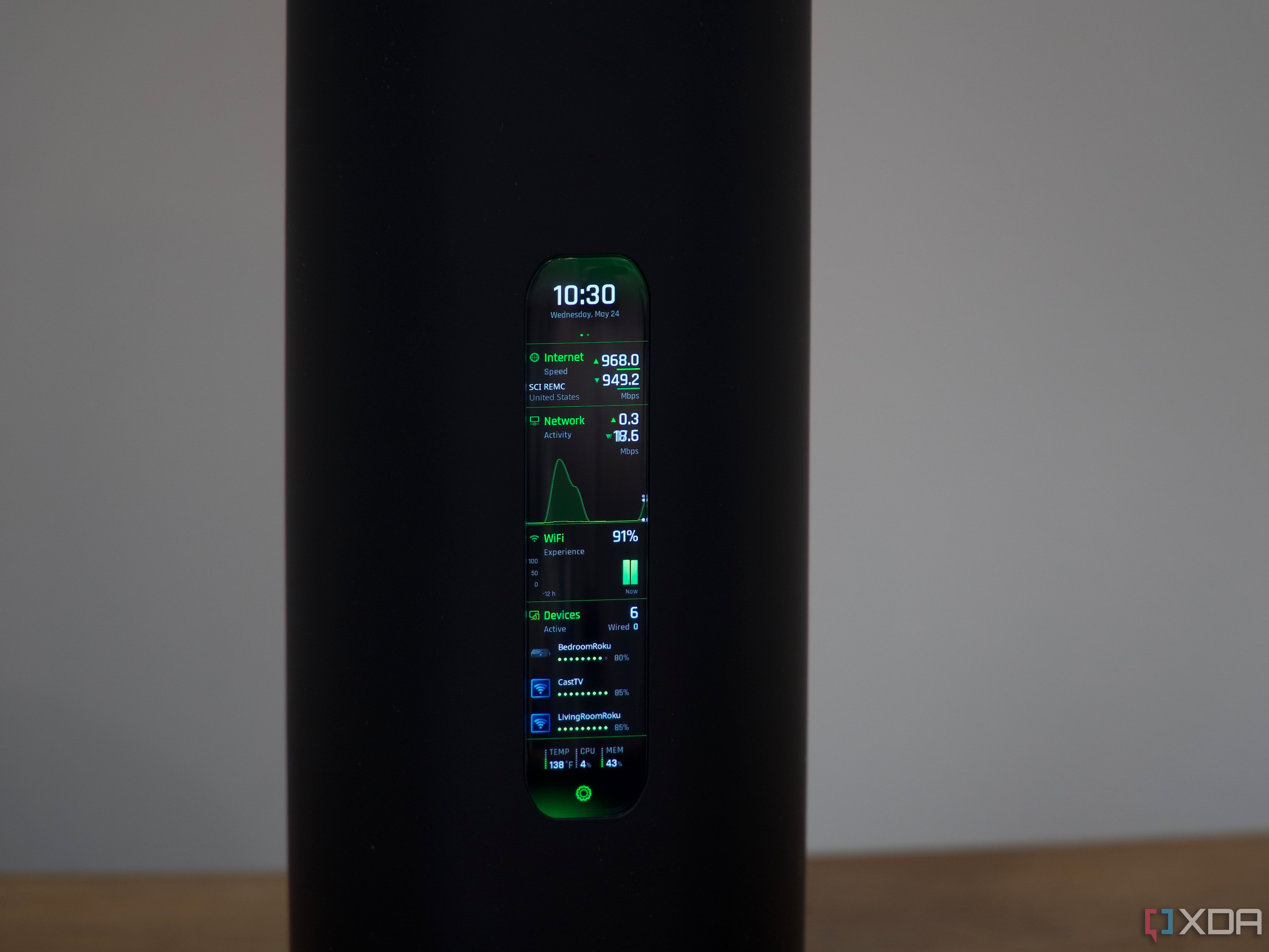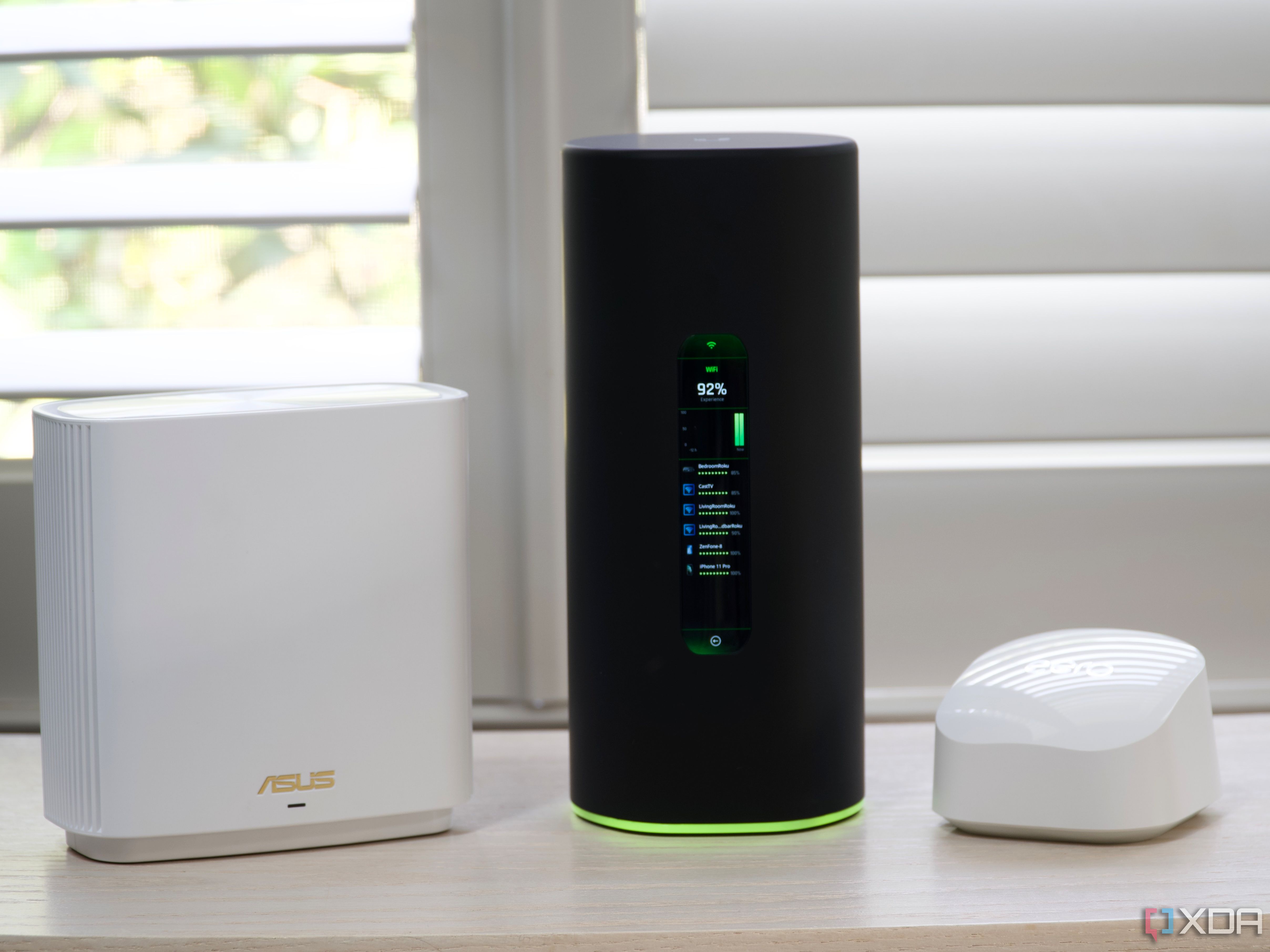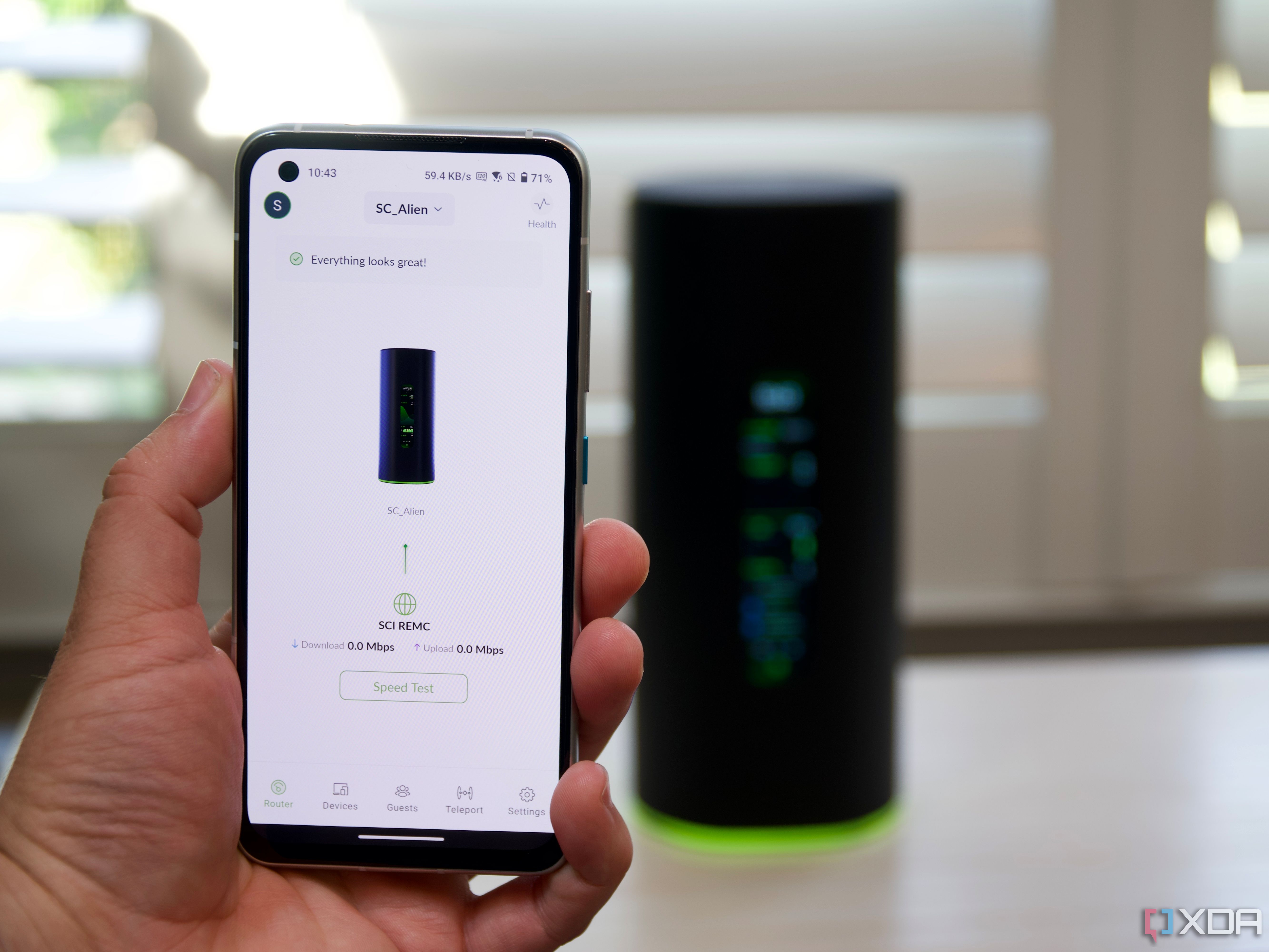AmpliFi isn’t the first name to come to mind regarding WI-Fi routers, but if you’ve been gravitating towards sleek and simple mesh solutions like eero and Nest Wifi, AmpliFi should be on your radar. I love the matte black design that stands out with its green underflow and touchscreen. The Alien looks good enough to leave front and center and with night mode shutting off the lighting at night, it’s not bothersome when watching TV in the dark.
On the software side, AmpliFi has kept things simple but its app nails the basics with more settings than a standard mesh system without the complexity of a traditional router. AmpliFi Alien helps you feel in control of your home network even if this is the first router you’ve purchased. Unfortunately, its design seems to have gotten in the way of performance a bit with coverage failing to live up to my expectations with upload speeds starting to fall off a couple of rooms away from the router. It seems that even with a three-bedroom house like ours, the best way to use Alien is in a mesh.
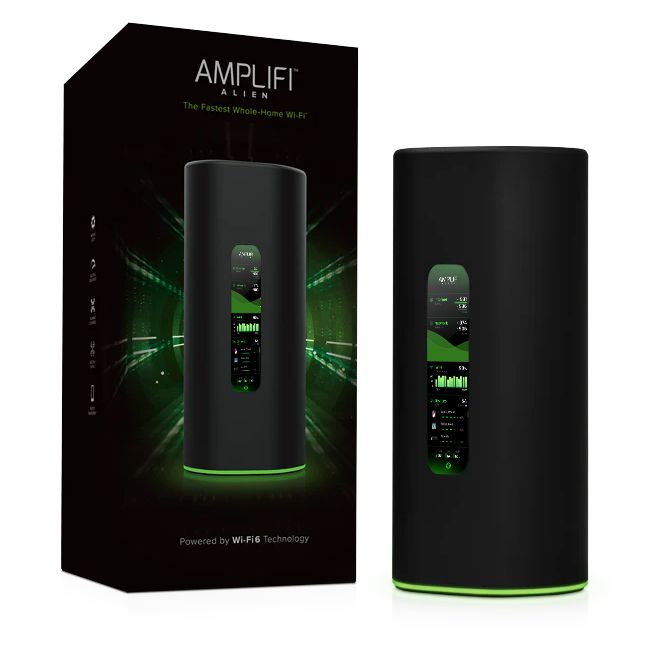
Source: AmpliFi

AmpliFi Alien
Recommended
The AmpliFi Alien is a tri-band Wi-Fi 6 router with simple software and 7685Mbps of total speed. With a matte black finish and touchscreen on the front, the Alien looks right at home in my living room. The Alien can also be purchased with a mesh point for added coverage if you have a large home.
- Brand
- AmpliFi
- Wi-Fi Bands
- 20, 40, 80, 160 Mhz (5GHz); 20, 20/40 MHz (2.4Ghz)
- Ethernet Ports
- 1x WAN, 4x LAN
- USB Ports
- No
- MU-MIMO
- 2.4 GHz: 4×4; 5 GHz: 4×4 + 8×8
- Mesh Network Compatible
- Yes
- Supported standards
- Up to Wi-Fi 6 (802.11ax)
- Speeds
- 2.4 GHz: 1148 Mbps; 5 Ghz: Up to 4804 Mbps + 1733 Mbps
- Security
- WPA2
- Chipset/memory
- 2.2 GHz 64-bit Quad-Core CPU
- App requirements
- AmpliFi WiFi app available
- Dimensions
- 110 x 110 x 250 mm (4.33 x 4.33 x 9.84″)
- Misc
- Front LED touchscreen display
- Ports
- 4x LAN, 1x WAN, 1x power
- Price
- $380
- Solid tri-band speeds
- Touchscreen quickly shows network status
- Can be used without an account
- 160MHz support on both 5GHz bands
- Compact size
- Coverage with a single router isn?t great
- Lacks advanced network controls
- One 5GHz band is Wi-Fi 5 (and off by default)
- Simple parental controls
AmpliFi Alien: Price and availability
AmpliFi Alien is far from the cheapest Wi-Fi 6 router you can buy, even at its speed. The base router costs $380 and can be purchased as a kit with an Alien Mesh Point for $700. A single router is expected to cover up to 3,000 square feet and up to 6,000 square feet with the mesh point. For most homes, a single router should be adequate, but if you have a large home and want consistent speeds all over the house, a mesh is the way to go.
AmpliFi Alien is available at retailers such as Best Buy, B&H, and on AmpliFi’s own web store. There’s no getting around it, the Alien is an expensive router and if you’re looking to get the absolute bang for your buck, you’re better off with one of the other best Wi-Fi routers.
Design and hardware
Even considering some of the excellent designs that have come to mesh routers in recent years such as ASUS ZenWiFi, Google Nest, and Netgear Orbi, the Alien looks great. Its matte black cylindrical design looks subtle enough to keep out in the open in my living room. It’s fairly compact at just 4.33 inches in diameter and 9.84 inches tall. The power and WAN connections are in a recess on the bottom, so you can place it close to a wall. Just be sure to leave a little room for airflow to keep it cool.
Even the green light ring around the base has grown on me in the past few weeks using the router. The star of the show has to be the bright and vibrant touchscreen on the front. You can see how your network is being used and which devices are connected at a glance. The screen and light will turn off automatically at night when night mode is enabled if green isn’t your preferred accent color. You can even use the screen to perform a speed test and change the lighting settings without having to open the AmpliFi app. Not that opening the app is a bad thing.
AmpliFi advertises this router as having 7685Mbps of total capacity with 16 spatial streams, but it’s not quite that straightforward. The Alien has two Wi-Fi 6 bands at 2.4GHz and 5GHz with an additional Wi-Fi 5 5GHz band available. That makes it a 12-stream AX6000 Wi-Fi 6 router plus a four-stream Wi-Fi 5 band with 1733Mbps of capacity.
Around the back, you get four gigabit Ethernet ports for any wired devices you wish to get connected. Many mesh-focused routers have reduced their wired capacity, so it’s nice to see a full four-port wired switch is included.
Setup and software
The best way to set up the Alien is with the AmpliFi app on Android or iOS. The app was fast and responsive on the Zenfone 8 I used for testing and setup went off without a hitch. The Alien was also quick to start up with a loading bar onscreen, so you know exactly when your internet is up.
One of the nicest things about the Alien was that I didn’t have to create an account to set it up and use most of its features. This may sound normal if you haven’t used a modern mesh system like eero or Orbi, but it’s getting much rarer as these companies try to get people to sign on to subscription services. Unfortunately, it’s a rare pleasure to set up a new device without being forced to enter your personal information.
AmpliFi Teleport does require an account, however. AmpliFi Teleport allows you to use a VPN connection to connect through your home network while you’re away from home. This is set up automatically through the AmpliFi app. The Alien isn’t the only router to offer this feature, but its version is certainly one of the easiest to set up and use.
Once I got the router set up, I was prompted to apply an update which took just a few minutes to complete. One thing that advanced users might notice is that when this router starts up, the 2.4GHz band starts up first with 5GHz coming in a minute or so later. With band steering on, your devices should switch to 5GHz on their own, but if not, toggling the Wi-Fi on and off should get you connected. If you want manual control over which bands your device uses, you can also set the Alien to broadcast each band with its own SSID.
Once your network is set up, the main screen of the app will show you the status of your network and the connected devices. You can tap the icon that looks like an ECG heartbeat signal to check your connectivity.
Moving to the right, you’ll see a list of all the devices connected to your network. You can add them to a group for family control, or temporarily pause their access to the internet. You’ll also be able to choose from two QoS settings: streaming and gaming.
QoS is a feature designed to keep your most important device performing consistently, even when sharing the network with several other devices.
Left on normal, a device will be given no special treatment and the available internet speed will be distributed equally. Devices labeled as streaming will be treated as a higher priority to avoid buffering on a slower connection. The gaming setting is the highest priority and is even useful on a fast internet connection. The gaming setting can keep ping times consistent which is important for avoiding lag spikes that are noticeable in game. These settings are fairly basic compared to something like an ROG gaming router, but a nice addition for a simple router like this.
AmpliFi Alien allows for QoS settings by individually labeling devices as normal, streaming, or gaming.
When it comes to the rest of your network, the settings available in the app are generally strong. You can change the basics like your network name and password, but you’re also able to broadcast individual SSIDs for each band if you want, You can disable band steering, enable router steering if you’ve got a mesh, and even create an IOT network.
AmpliFi offers a few advanced wireless settings that allow you to change the channel and the bandwidth of each of your Wi-Fi 6 bands. This page is also where you’ll be able to enable DFS bands to open up some more 5GHz spectrum. DFS can use 5GHz spectrum reserved for radar systems if no radar signal is detected. This is also where you’ll be able to enable 160MHz which can improve speeds on devices that support it. This is also true for the WI-Fi 5 band and link speeds up to 1733Mbps are possible. Both 5GHz bands can be set to 160MHz at the same time.
Another thing to keep in mind is that the parental controls are rather weak. I was able to group devices into different profiles, but the only options were to pause internet access and set restricted times. For example, you could set your child’s Xbox to stop connecting to the internet at bedtime to make sure no one is sneaking some after-hours gaming.
If you’re looking for advanced settings in your web browser, you’ll be disappointed as they’re the same as the app. Despite the basic settings, I rarely felt myself wanting because, perceptually, performance was strong. More objective testing, on the other hand, revealed some weaknesses.
Wireless performance
AmpliFi estimates up to 3,000 square feet of coverage with a single router, and while the signal was strong for a device this size, it doesn’t quite measure up to some other high-end routers I’ve tested here like the Orbi RBR860 and TP-Link Archer AXE300. Even so, I was mostly happy with my speeds and everything from streaming 4K HDR video to my bedroom TV to downloading a PS5 game was quick.
I have a symmetrical gigabit internet connection from a local fiber provider and generally get over 940Mbps wired, so the Alien had its work cut out for it. As a reminder, symmetrical connections deliver the same download speeds as upload so in ideal conditions, I can upload at gigabit speeds. This is different from cable providers that have prioritized download speeds over upload, so many people will never see upload speeds over 50Mbps at home.
I used Ookla’s Speedtest app to see how well the Alien kept up with a gigabit connection. After all, AmpliFi recommends this router for people with internet connections up to 1Gbps.
AmpliFi Alien internet speed tests (download/upload):
|
Device |
Living room (router) |
Garage |
Bedroom |
|---|---|---|---|
|
LG G8 (Wi-Fi 5) |
667/629Mbps, 665/620Mbps |
465/381Mbps, 621/367Mbps |
448/153Mbps, 464/110Mbps |
|
Galaxy S20 (Wi-Fi 6 80MHz) |
847/682Mbps, 828/703Mbps |
758/416Mbps, 760/410Mbps |
528/63.7Mbps, 495/64.1Mbps |
|
Zenfone 8 (Wi-Fi 6 160MHz) |
923/947Mbps, 890/930Mbps |
559/738Mbps, 703/819Mbps |
707/304Mbps, 670/292Mbps |
Ping times we’re good with under 10ms of idle latency most of the time. This is a little higher than my wired results, but right around normal for wireless.
Overall, download speeds were strong, but in the bedroom location, upload speeds were much weaker than I expected. Most of my internet usage in there is streaming or downloading titles on Steam or PS5 so, to be honest, I didn’t really notice the weak upload speeds until I ran the speed tests. If you’re looking for high upload speed a couple of rooms away from your router, the Alien probably isn’t the right fit for you.
One thing to notice is that the Zenfone 8 had generally higher speeds overall. This phone supports 160MHz connections, sometimes called HE160 on spec sheets, which gives it a maximum link speed to the router of 2402Mbps whereas the 80MHz Galaxy S20 gets only 1201Mbps. The extra headroom from 160MHz helps the Zenfone to maintain higher speeds when signal is lower. Many of the best phones like the Galaxy S23 Ultra and Pixel 7 Pro support 160MHz Wi-Fi.
The Wi-Fi 5 band was also a strong performer and put up similar numbers to the Wi-Fi 6 band. It’s a more limited band with only 4×4 MIMO compared to 8×8 on Wi-Fi 6, but it’s still nice to have the option for devices that don’t need a ton of speed.
Competition
One of the best mesh Wi-Fi routers you can get is the ASUS ZenWiFi XT8. This router can be purchased alone or as a mesh kit and gives the customer access to just about any advanced option they can think of. It has a quick AX6600 tri-band Wi-Fi 6 connection with one 5GHz band operating at up to 1201Mbps and the other at 4804Mbps. ASUS’s software isn’t quite as user-friendly, but it makes up for it in options. You can change just about anything from power levels to smart connect sensitivity. You can even enable the free AiProteciton Pro for some extra network security or its advanced parental controls with content filters.
ASUS also makes building a mesh flexible and cheap. Just about every ASUS router from the past few years supports AiMesh and can be part of a mesh with one another. That means you could even use an ASUS gaming router with the more living room-friendly ZenWiFi nodes to get both gaming features and prioritization, and mesh coverage. You could also simply buy more ZenWiFi XT8 nodes. Each node is estimated to cover up to 2750 square feet, not quite as much as the Alien, but the lower price makes up for it if you’re setting up a mesh.
Another consideration is eero 6+ with its AX3000 dual-band connection and 1,500 square feet of coverage per node. Unless you live in a studio apartment or a small house, you’ll want at least two of these. That’s not too bad, as a two-pack with up to 3,000 square feet of coverage, the same as a single Alien, costs around $150 less. Sure, you’re not getting the same speeds as the Alien, but an eero 6+ mesh is plenty fast for the majority of people.
Keep in mind that eero strips down the settings even more than AmpliFi and requires you to set up an account with Amazon to use the app. Eero will also try to get you to sign up for its eero Plus subscription service, which isn’t necessarily a bad value, but could be an unexpected cost.
AmpliFi Alien: Should you buy it?
The worst thing about the AmpliFi Alien is its price. It’s a lovely router to use and set up with its easy-to-use app and responsive software, but the real-world coverage you get, and the lack of advanced parental controls somewhat sour the experience. If you’re not looking for parental controls, that’s not an issue, but there are people looking to keep a close eye on what their kids are doing online, and Alien is not a solution for that. For the rest of us, the router has all the right features to allow you to feel in control of your network without being overwhelmed. For the people that want to install custom software and fine-tune every setting, this isn’t the router for you.
As a simple router I can recommend it to just about anyone; I like the AmpliFi Alien. It has strong performance out of the box with a user experience that’s simple enough to keep inexperienced users from feeling overwhelmed with just enough advanced settings to allow me to feel in control of my network. It has enough coverage for many homes, but if I were to keep using it, I feel I would add another router to make a mesh, which would be rather expensive. The Alien has been one of my favorite routers to use and hasn’t given me a moment of trouble in day-to-day usage.

Source: AmpliFi
AmpliFi Alien
The AmpliFi Alien is a tri-band Wi-Fi 6 router with simple software and 7685Mbps of total speed. With a matte black finish and touchscreen on the front, the Alien looks right at home in my living room. The Alien can also be purchased with a mesh point for added coverage if you have a large home.
[ad_2]


